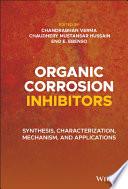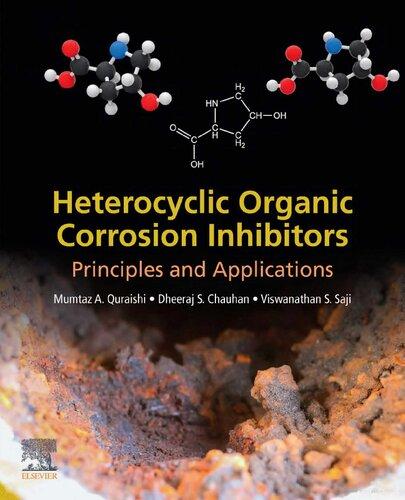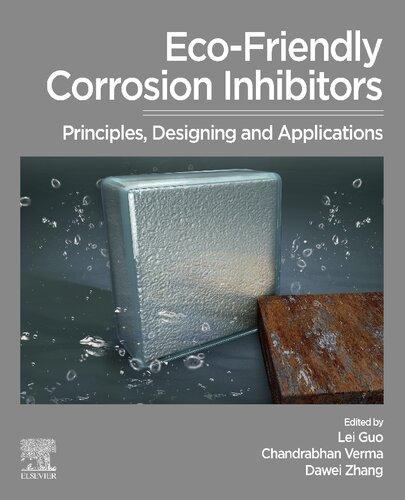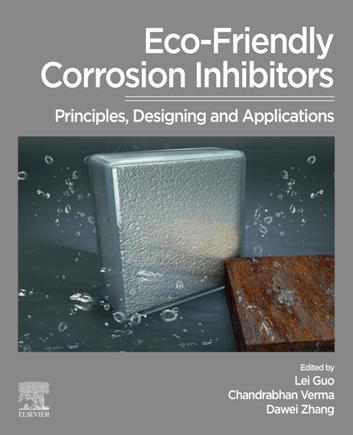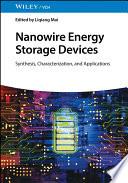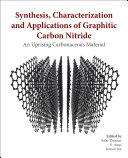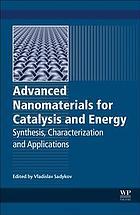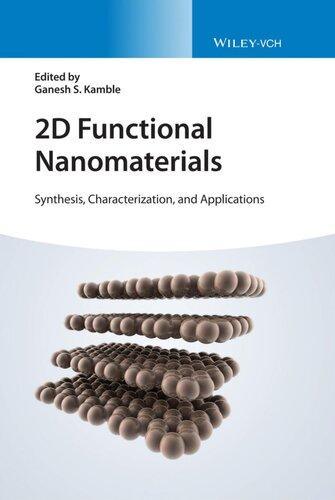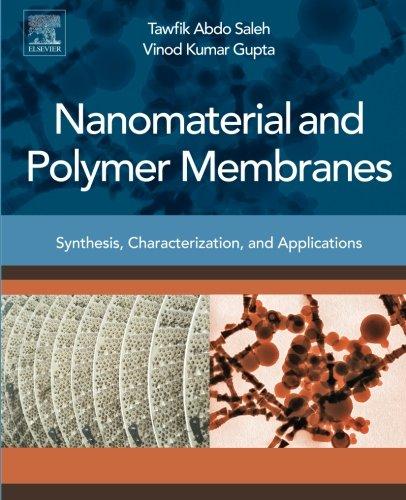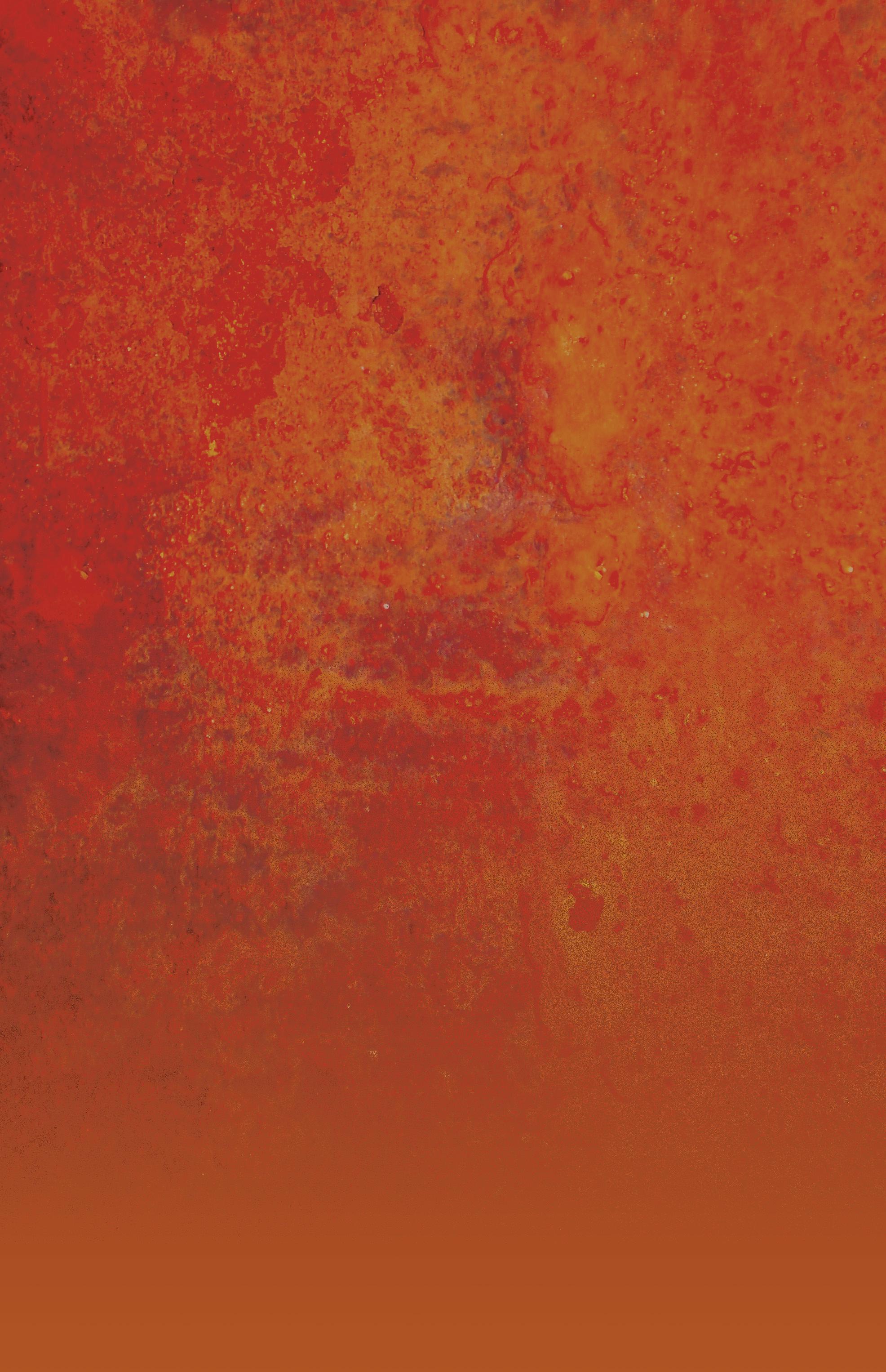Organic Corrosion Inhibitors
Synthesis, Characterization, Mechanism, and Applications
Edited by
Chandrabhan Verma
King Fahd University of Petroleum and Minerals
Dhahran, Saudi Arabia
Chaudhery Mustansar Hussain
New Jersey Institute of Technology
Newark, NJ, USA
Eno E. Ebenso
University of South Africa
Johannesburg, South Africa
This edition first published 2022 © 2022 John Wiley & Sons, Inc.
All rights reserved. No part of this publication may be reproduced, stored in a retrieval system, or transmitted, in any form or by any means, electronic, mechanical, photocopying, recording or otherwise, except as permitted by law. Advice on how to obtain permission to reuse material from this title is available at http://www.wiley.com/go/permissions.
The right of Chandrabhan Verma, Chaudhery Mustansar Hussain, and Eno E. Ebenso to be identified as author(s) of the editorial material in this work has been asserted in accordance with law.
Registered Office
John Wiley & Sons, Inc., 111 River Street, Hoboken, NJ 07030, USA
Editorial Office
111 River Street, Hoboken, NJ 07030, USA
For details of our global editorial offices, customer services, and more information about Wiley products visit us at www.wiley.com.
Wiley also publishes its books in a variety of electronic formats and by print-on-demand. Some content that appears in standard print versions of this book may not be available in other formats.
Limit of Liability/Disclaimer of Warranty
In view of ongoing research, equipment modifications, changes in governmental regulations, and the constant flow of information relating to the use of experimental reagents, equipment, and devices, the reader is urged to review and evaluate the information provided in the package insert or instructions for each chemical, piece of equipment, reagent, or device for, among other things, any changes in the instructions or indication of usage and for added warnings and precautions. While the publisher and authors have used their best efforts in preparing this work, they make no representations or warranties with respect to the accuracy or completeness of the contents of this work and specifically disclaim all warranties, including without limitation any implied warranties of merchantability or fitness for a particular purpose. No warranty may be created or extended by sales representatives, written sales materials or promotional statements for this work. The fact that an organization, website, or product is referred to in this work as a citation and/or potential source of further information does not mean that the publisher and authors endorse the information or services the organization, website, or product may provide or recommendations it may make. This work is sold with the understanding that the publisher is not engaged in rendering professional services. The advice and strategies contained herein may not be suitable for your situation. You should consult with a specialist where appropriate. Further, readers should be aware that websites listed in this work may have changed or disappeared between when this work was written and when it is read. Neither the publisher nor authors shall be liable for any loss of profit or any other commercial damages, including but not limited to special, incidental, consequential, or other damages.
Library of Congress
Cataloging-in-Publication Data
Names: Verma, Chandrabhan, editor. | Hussain, Chaudhery Mustansar, editor. | Ebenso, Eno E., editor.
Title: Organic corrosion inhibitors : synthesis, characterization, mechanism, and applications / edited by Chandrabhan Verma, Chaudhery Mustansar Hussain, Eno E. Ebenso.
Description: First edition. | Hoboken, NJ : Wiley, 2022. | Includes index.
Identifiers: LCCN 2021031915 (print) | LCCN 2021031916 (ebook) | ISBN 9781119794486 (cloth) | ISBN 9781119794493 (adobe pdf) | ISBN 9781119794509 (epub)
Subjects: LCSH: Corrosion and anti-corrosives. | Corrosion and anti-corrosives–Environmental aspects.
Classification: LCC TA462 .O65 2022 (print) | LCC TA462 (ebook) | DDC 620.1/1223–dc23
LC record available at https://lccn.loc.gov/2021031915
LC ebook record available at https://lccn.loc.gov/2021031916
Cover Design and Image: Wiley
Set in 9.5/12.5pt STIXTwoText by Straive, Pondicherry, India 10 9 8 7 6 5 4 3 2 1
Contents
Preface xv
About the Editors xvii
List of Contributors xix
Part I Basics of Corrosion and Prevention 1
1 An Overview of Corrosion 3
Marziya Rizvi
1 Introduction 3
1.1 Basics About Corrosion 3
1.2 Economic and Social Aspect of Corrosion 4
1.3 The Corrosion Mechanism 5
1.3.1 Anodic Reaction 6
1.3.2 Cathodic Reactions 7
1.4 Classification of Corrosion 8
1.4.1 Uniform Corrosion 8
1.4.2 Pitting Corrosion 9
1.4.3 Crevice Corrosion 9
1.4.4 Galvanic Corrosion 9
1.4.5 Intergranular Corrosion 10
1.4.6 Stress- Corrosion Cracking (SCC) 10
1.4.7 Filiform Corrosion 10
1.4.8 Erosion Corrosion 10
1.4.9 Fretting Corrosion 11
1.4.10 Exfoliation 11
1.4.11 Dealloying 11
1.4.12 Corrosion Fatigue 11
1.5 Common Methods of Corrosion Control 11
1.5.1 Materials Selection and Design 12
1.5.2 Coatings 12
1.5.3 Cathodic Protection (CP) 12
1.5.4 Anodic Protection 13
1.5.5 Corrosion Inhibitors 13
1.6 Adsorption Type Corrosion Inhibitors 13
1.6.1 Anodic Inhibitors 14
1.6.2 Cathodic Inhibitors 14
1.6.3 Mixed Inhibitors 14
1.6.4 Green Corrosion Inhibitors 15
References 15
2 Methods of Corrosion Monitoring 19
Sheerin Masroor
2.1 Introduction 19
2.2 Methods and Discussion 21
2.2.1 Corrosion Monitoring Techniques 21
2.3 Conclusion 33
References 33
3 Computational Methods of Corrosion Monitoring 39 Hassane Lgaz, Abdelkarim Chaouiki, Mustafa R. Al-Hadeethi, Rachid Salghi, and Han-Seung Lee
3.1 Introduction 39
3.2 Quantum Chemical (QC) Calculations-Based DFT Method 40
3.2.1 Theoretical Framework 40
3.2.2 Theoretical Application of DFT in Corrosion Inhibition Studies: Design and Chemical Reactivity Prediction of Inhibitors 42
3.2.2.1 HOMO and LUMO Electron Densities 43
3.2.2.2 HOMO and LUMO Energies 43
3.2.2.3 Electronegativity (ɳ), Chemical Potential (μ), Hardness (η), and Softness (σ) Indices 43
3.2.2.4 Electron-Donating Power (ω ) and Electron-Accepting Power (ω+) 44
3.2.2.5 The Fraction of Electrons Transferred (ΔN) 44
3.2.2.6 Fukui Indices (FIs) 45
3.3 Atomistic Simulations 45
3.3.1 Molecular Dynamics (MD) Simulations 46
3.3.1.1 Total Energy Minimization 46
3.3.1.2 Ensemble 47
3.3.1.3 Force Fields 47
3.3.1.4 Periodic Boundary Condition 47
3.3.2 Monte Carlo (MC) Simulations 48
3.3.3 Parameters Derived from MD and MC Simulations of Corrosion Inhibition 48
3.3.3.1 Interaction and Binding Energies 49
3.3.3.2 Radial Distribution Function 50
3.3.3.3 Mean Square Displacement, Diffusion Coefficient, and Fractional Free Volume 50
Acknowledgments 51
Suggested Reading 51
References 51
4 Organıc and Inorganıc Corrosıon Inhıbıtors: A Comparıson 59
Goncagül Serdaroglu and Savas Kaya
4.1 Introduction 59
4.2 Corrosion Inhibitors 61
4.2.1 Organic Corrosion Inhibitors 61
4.2.1.1 Azoles 62
4.2.1.2 Azepines 63
4.2.1.3 Pyridine and Azines 64
4.2.1.4 Indoles 65
4.2.1.5 Quinolines 66
4.2.1.6 Carboxylic Acid and Biopolymers 67
4.2.1.7 Inorganic Corrosion Inhibitors 68
4.2.1.8 Anodic Inhibitors 69
4.2.1.9 Cathodic Inhibitors 69
References 69
Part II Heterocyclic and Non-Heterocyclic Corrosion Inhibitors 75
5 Amines as Corrosion Inhibitors: A Review 77
Chandrabhan Verma, M. A. Quraishi, Eno E. Ebenso, and Chaudhery Mustansar Hussain
5.1 Introduction 77
5.1.1 Corrosion: Basics and Its Inhibition 77
5.1.2 Amines as Corrosion Inhibitors 78
5.1.2.1 10-, 20-, and 30-Aliphatic Amines as Corrosion Inhibitors 79
5.1.2.2 Amides and Thio-Amides as Corrosion Inhibitors 81
5.1.2.3 Schiff Bases as Corrosion Inhibitors 82
5.1.2.4 Amine-Based Drugs and Dyes as Corrosion Inhibitors 85
5.1.2.5 Amino Acids and Their Derivatives as Corrosion Inhibitors 88
5.2 Conclusion and Outlook 88
Important Websites 89
References 89
6 Imidazole and Its Derivatives as Corrosion Inhibitors 95
Jeenat Aslam, Ruby Aslam, and Chandrabhan Verma
6.1 Introduction 95
6.1.1 Corrosion and Its Economic Impact 95
6.2 Corrosion Mechanism 96
6.3 Corrosion Inhibitors 97
6.4 Corrosion Inhibitors: Imidazole and Its Derivatives 98
6.5 Computational Studies 110
6.6 Conclusions 113
References 113
7 Pyridine and Its Derivatives as Corrosion Inhibitors 123
Chandrabhan Verma, M. A. Quraishi, and Chaudhery Mustansar Hussain
7.1 Introduction 123
7.1.1 Pyridine and Its Derivatives as Corrosion Inhibitors 124
7.1.2 Literature Survey 125
7.1.2.1 Substituted Pyridine as Corrosion Inhibitors 125
7.1.3 Pyridine-Based Schiff Bases (SBs) as Corrosion Inhibitors 129
7.1.4 Quinoline-Based Compounds as Corrosion Inhibitors 130
7.2 Summary and Outlook 130
References 140
8 Quinoline and Its Derivatives as Corrosion Inhibitors 149
Chandrabhan Verma and M. A. Quraishi
8.1 Introduction 149
8.2 Quinoline and Its Derivatives as Corrosion Inhibitors 151
8.2.1 8-Hydroxyquinoline and Its Derivatives as Corrosion Inhibitors 152
8.2.2 Quinoline Derivatives Other Than 8-hydroxyquinoline as Corrosion Inhibitors 156
8.3 Conclusion and Outlook 160
References 161
9 Indole and Its Derivatives as Corrosion Inhibitors 167
Taiwo W. Quadri, Lukman O. Olasunkanmi, Ekemini D. Akpan, and Eno E. Ebenso
9.1 Introduction 167
9.2 Synthesis of Indoles and Its Derivatives 168
9.3 A Brief Overview of Corrosion and Corrosion Inhibitors 171
9.4 Application of Indoles as Corrosion Inhibitors 172
9.4.1 Indoles as Corrosion Inhibitors of Ferrous Metals 173
9.4.2 Indoles as Corrosion Inhibitors of Nonferrous Metals 192
9.5 Corrosion Inhibition Mechanism of Indoles 201
9.6 Theoretical Modeling of Indole-Based Chemical Inhibitors 202
9.7 Conclusions and Outlook 205
References 207
10 Environmentally Sustainable Corrosion Inhibitors in Oil and Gas Industry 221
M. A. Quraishi and Dheeraj Singh Chauhan
10.1 Introduction 221
10.2 Corrosion in the Oil–Gas Industry 222
10.2.1 An Overview of Corrosion 222
10.2.2 Corrosion of Steel Structures During Acidizing Treatment 223
10.2.3 Limitations of the Existing Oil and Gas Corrosion Inhibitors 223
10.3 Review of Literature on Environmentally Sustainable Corrosion Inhibitors 223
10.3.1 Plant Extracts 223
10.3.2 Environmentally Benign Heterocycles 224
10.3.3 Pharmaceutical Products 226
10.3.4 Amino Acids and Derivatives 228
10.3.5 Macrocyclic Compounds 229
10.3.6 Chemically Modified Biopolymers 229
10.3.7 Chemically Modified Nanomaterials 231
10.4 Conclusions and Outlook 233
References 235
Part III Organic Green Corrosion Inhibitors 241
11 Carbohydrates and Their Derivatives as Corrosion Inhibitors 243
Jiyaul Haque and M. A. Quraishi
11.1 Introduction 243
11.2 Glucose-Based Inhibitors 244
11.3 Chitosan-Based Inhibitors 246
11.4 Inhibition Mechanism of Carbohydrate Inhibitor 251
11.5 Conclusions 252
References 252
12 Amino Acids and Their Derivatives as Corrosion Inhibitors 255
Saman Zehra and Mohammad Mobin
12.1 Introduction 255
12.2 Corrosion Inhibitors 257
Contents x
12.3 Why There Is Quest to Explore Green Corrosion Inhibitors? 258
12.4 Amino Acids and Their Derived Compounds: A Better Alternate to the Conventional Toxic Corrosion Inhibitors 261
12.4.1 Amino Acids: A General Introduction 261
12.4.2 A General Mechanistic Aspect of the Applicability of Amino Acids and Their Derivatives as Corrosion Inhibitors 263
12.4.3 Factors Influencing the Inhibition Ability of Amino Acids and Their Derivatives 264
12.5 Overview of the Applicability of Amino Acid and Their Derivatives as Corrosion Inhibitors 264
12.5.1 Amino Acids and Their Derivatives as Corrosion Inhibitor for the Protection of Copper in Different Corrosive Solution 265
12.5.2 Amino Acids and Their Derivatives as Corrosion Inhibitor for the Protection of Aluminum and Its Alloys in Different Corrosive Solution 266
12.5.3 For the Protection of Iron and Its Alloys in Different Corrosive Solution 272
12.6 Recent Trends and the Future Considerations 277
12.6.1 Synergistic Combination of Amino Acids with Other Compounds 277
12.6.2 Self-Assembly Monolayers (SAMs) 278
12.6.3 Amino Acid-Based Ionic Liquids 278
12.6.4 Amino Acids as Inhibitors in Smart Functional Coatings 279
12.7 Conclusion 280
Acknowledgments 281
References 281
13 Chemical Medicines as Corrosion Inhibitors 287
Mustafa R. Al-Hadeethi, Hassane Lgaz, Abdelkarim Chaouiki, Rachid Salghi, and Han-Seung Lee
13.1 Introduction 287
13.2 Greener Application and Techniques Toward Synthesis and Development of Corrosion Inhibitors 288
13.2.1 Ultrasound Irradiation-Assisted Synthesis 288
13.2.2 Microwave-Assisted Synthesis 289
13.2.3 Multicomponent Reactions 289
13.3 Types of Chemical Medicine-Based Corrosion Inhibitors 291
13.3.1 Drugs 291
13.3.2 Expired Drugs 291
13.3.3 Functionalized Drugs 292
13.4 Application of Chemical Medicines in Corrosion Inhibition 292
13.4.1 Drugs 292
13.4.2 Expired Drugs 297
13.4.3 Functionalized Drugs 305
Acknowledgments 306
References 306
14 Ionic Liquids as Corrosion Inhibitors 315 Ruby Aslam, Mohammad Mobin, and Jeenat Aslam
14.1 Introduction 315
14.2 Inhibition of Metal Corrosion 316
14.3 Ionic Liquids as Corrosion Inhibitors 317
14.3.1 In Hydrochloric Acid Solution 318
14.3.2 In Sulfuric Acid Solution 322
14.3.3 In NaCl Solution 334
14.4 Conclusion and Future Trends 335
Acknowledgment 336
Abbreviations 336
References 337
15 Oleochemicals as Corrosion Inhibitors 343 F. A. Ansari, Sudheer, Dheeraj Singh Chauhan, and M. A. Quraishi
15.1 Introduction 343
15.2 Corrosion 344
15.2.1 Definition and Economic Impact 344
15.2.2 Corrosion Inhibitors 344
15.3 Significance of Green Corrosion Inhibitors 345
15.4 Overview of Oleochemicals 345
15.4.1 Environmental Sustainability of Oleochemicals 345
15.4.2 Production/Recovery of Oleochemicals 346
15.5 Literatures on the Utilization of Oleochemicals as Corrosion Protection 349
15.6 Conclusions and Outlook 365 References 366
Part IV Organic Compounds-Based Nanomaterials as Corrosion Inhibitors 371
16 Carbon Nanotubes as Corrosion Inhibitors 373 Yeestdev Dewangan, Amit Kumar Dewangan, Shobha, and Dakeshwar Kumar Verma
16.1 Introduction 373
16.2 Characteristics, Preparation, and Applications of CNTs 374
16.3 CNTs as Corrosion Inhibitors 376
16.3.1 CNTs as Corrosion Inhibitors for Ferrous Metal and Alloys 376
16.3.2 CNTs as Corrosion Inhibitors for Nonferrous Metal and Alloys 377
16.4 Conclusion 381
Conflict of Interest 381
Acknowledgment 381
Abbreviations 381
References 382
17 Graphene and Graphene Oxides Layers Application as Corrosion Inhibitors in Protective Coatings 387
Renhui Zhang, Lei Guo, Zhongyi He, and Xue Yang
17.1 Introduction 387
17.2 Preparation of Graphene and Graphene Oxides 388
17.2.1 Graphene 388
17.2.2 N-doped Graphene and Its Composites 390
17.2.3 Graphene Oxides 390
17.3 Protective Film and Coating Applications of Graphene 390
17.4 The Organic Molecules Modified Graphene as Corrosion Inhibitor 398
17.5 The Effect of Dispersion of Graphene in Epoxy Coatings on Corrosion Resistance 399
17.6 Challenges of Graphene 404
17.7 Conclusions and Future Perspectives 404
References 406
Part V Organic Polymers as Corrosion Inhibitors 411
18 Natural Polymers as Corrosion Inhibitors 413
Marziya Rizvi
18.1 An Overview of Natural Polymers 413
18.2 Mucilage and Gums from Plants 415
18.2.1 Guar Gum 415
18.2.2 Acacia Gum 415
18.2.3 Xanthan Gum 417
18.2.4 Ficus Gum/Fig Gum 417
18.2.5 Daniella oliveri Gum 419
18.2.6 Mucilage from Okra Pods 419
18.2.7 Corn Polysaccharide 419
18.2.8 Mimosa/Mangrove Tannins 420
18.2.9 Raphia Gum 420
18.2.10 Various Butter-Fruit Tree Gums 420
18.2.11 Astragalus/Tragacanth Gum 421
18.2.12 Plantago Gum 421
18.2.13 Cellulose and Its Modifications 421
18.2.13.1 Carboxymethyl Cellulose 422
18.2.13.2 Sodium Carboxymethyl Cellulose 422
18.2.13.3 Hydroxyethyl Cellulose 422
18.2.13.4 Hydroxypropyl Cellulose 423
18.2.13.5 Hydroxypropyl Methyl Cellulose 423
18.2.13.6 Ethyl Hydroxyethyl Cellulose or EHEC 423
18.2.14 Starch and Its Derivatives 423
18.2.15 Pectin 424
18.2.16 Chitosan 425
18.2.17 Carrageenan 426
18.2.18 Dextrins 427
18.2.19 Alginates 427
18.3 The Future and Application of Natural Polymers in Corrosion Inhibition Studies 429 References 431
19 Synthetic Polymers as Corrosion Inhibitors 435 Megha Basik and Mohammad Mobin
19.1 Introduction 435
19.2 General Mechanism of Polymers as Corrosion Inhibitors 437
19.3 Corrosion Inhibitors – Synthetic Polymers 437
19.4 Conclusion 445
Useful Links 447
References 447
20 Epoxy Resins and Their Nanocomposites as Anticorrosive Materials 451 Omar Dagdag, Rajesh Haldhar, Eno E. Ebenso, Chandrabhan Verma, A. El Harfi, and M. El Gouri
20.1 Introduction 451
20.2 Characteristic Properties of Epoxy Resins 452
20.3 Main Commercial Epoxy Resins and Their Syntheses 453
20.3.1 Bisphenol A Diglycidyl Ether (DGEBA) 453
20.3.2 Cycloaliphatic Epoxy Resins 454
20.3.3 Trifunctional Epoxy Resins 455
20.3.4 Phenol-Novolac Epoxy Resins 456
20.3.5 Epoxy Resins Containing Fluorine 456
20.3.6 Epoxy Resins Containing Phosphorus 457
20.3.7 Epoxy Resins Containing Silicon 458
20.4 Reaction Mechanism of Epoxy/Amine Systems 459
20.5 Applications of Epoxy Resins 461
20.5.1 Epoxy Resins as Aqueous Phase Corrosion Inhibitors 461
20.5.2 Epoxy Resins as Coating Phase Corrosion Inhibitors 466
20.5.3 Composites of Epoxy Resins as Corrosion Inhibitors 467
20.5.4 Nanocomposites of Epoxy Resins as Corrosion Inhibitors 468
20.6 Conclusion 471
Abbreviations 471
References 472
Index 483
Preface
Corrosion is a highly dangerous phenomenon that causes huge economic and safety problems. Various methods of corrosion monitoring, including cathodic protection, panting and coatings, alloying and dealloying (reduction in metal impurities), surface treatments, and use of corrosion inhibitors have been developed depending upon the nature of metal and environment. Application of organic compounds, especially heterocyclic compounds, is one of the most common, practical, easy, and economic methods of corrosion mitigations. Obviously, these compounds become effective by adsorbing on the metallic surface using electron-rich centers including multiple bonds and polar functional groups. These electron-rich centers act as adsorption sites during their interaction with the metallic surface. Along with acting as adsorption sites, the polar functional groups such as –OH (hydroxyl), –NH2 (amino), –OMe (methoxy), –COOH (carboxyl), –NO2 (nitro), –CN (nitrile), and so on also enhance solubility of organic compounds in polar electrolytes. Present book describes the collection of major advancements in using organic compounds as corrosion inhibitors including their synthesis, characterization, and corrosion inhibition mechanism.
Through this book it can be seen that use of organic compounds serves as one of the most effective, economic, and ease methods of corrosion monitoring. Using previously developed methods, 15% (US $375) to 35% (US $875) of cost of corrosion can be minimized. Different series of organic compounds, including heterocyclic compounds, are effectively used as corrosion inhibitors for different metals and alloys in various environments. Because of the increasing ecological awareness and strict environmental regulations, various classes of environmentalfriendly alternatives to the traditional toxic corrosion inhibitors have been developed and being implemented. These series of compounds mostly include carbohydrates, natural polymers and amino acids (AAs), and their derivatives. Corrosion scientists and engineers strongly believe that these environmentalfriendly alternatives will be capable to replace, in the near future, the toxic marketable products that are still being used via many worldwide industries.
A book covering the recent developments on using organic compounds as corrosion inhibitors is broadly overdue. It has been addressed by Drs. Verma, Hussain, and Ebenso in this book which attends to fundamental characteristics of organic corrosion inhibitors, their synthesis and characterization, chronological growths, and their industrial applications. The corrosion inhibition using organic compounds, especially heterocyclic compounds, is broad ranging. This book is divided into five sections, where each section contains several chapters. Section 1 “Basics of corrosion and prevention” describes the basic of corrosion, experimental and computational testing of corrosion, and a comparison between organic and inorganic corrosion inhibitors. Section 2 “Heterocyclic and non-heterocyclic corrosion inhibitors” describes the collection of different series of heterocyclic and non-heterocyclic corrosion inhibitors such as amines, imidazole, quinoline, pyridine, indole, and their derivatives. This section also includes organic compounds as corrosion inhibitors for oil and gas industries.
Section 3 “Organic green corrosion inhibitors” entirely focuses on green corrosion inhibitors. This section describes the corrosion inhibition characteristics of carbohydrates, amino acids (AAs), oleochemicals, chemical medicines, ionic liquids (ILs), and their derivatives. Section 4 “Organic compounds based nanomaterials as corrosion inhibitors” describes the corrosion inhibition properties of carbon nanotubes (CNTs: SWCNTs and MWCNTs), graphene oxide (GO), and their composites. In the end, Section 5 “Organic polymers as corrosion inhibitors” gives a description on natural and synthetic polymers as corrosion inhibitors. Overall, this book is written for scholars in academia and industry, working corrosion engineering, materials science students, and applied chemistry. The editors and contributors are well-known researchers, scientists, and true professionals from academia and industry. On behalf of Wiley, we are very thankful to authors of all chapters for their amazing and passionate efforts in making of this book. Special thanks to Prof. M. A. Quraishi, who guided us continuously in drafting of this book. Special thanks to Michael Leventhal (acquisitions editor) and Katrina Maceda (managing editor) for their dedicated support and help during this project. In the end, all thanks to Wiley for publishing the book.
Chandrabhan Verma, PhD
Chaudhery Mustansar Hussain, PhD
Eno E. Ebenso, PhD
About the Editors
Chandrabhan Verma is working at the Interdisciplinary Center for Research in Advanced Materials King Fahd University of Petroleum and Minerals (KFUPM), Saudi Arabia. He obtained his PhD in Corrosion Science at the Department of Chemistry, Indian Institute of Technology (Banaras Hindu University) Varanasi, India. He is a member of American Chemical Society (ACS). His research is mainly focused on the synthesis and designing of environmental friendly corrosion inhibitors useful for various industrial applications. Dr. Verma is the author of several research and review articles published in the peer-reviewed international journals of ACS, Elsevier, RSC, Wiley, Springer, etc. He has total citation of more than 4700 with H-index of 39 and i10-index of 91. Dr. Verma received several national and international awards for his academic achievements.

Chaudhery Mustansar Hussain, PhD, is an adjunct professor and director of labs in the Department of Chemistry & Environmental Sciences at the New Jersey Institute of Technology (NJIT), Newark, New Jersey, USA. His research is focused on the applications of nanotechnology & advanced technologies & materials, analytical chemistry, environmental management, and various industries. Dr. Hussain is the author of numerous papers in peerreviewed journals, as well as prolific author and editor of several scientific
Chandrabhan Verma
Chaudhery Mustansar Hussain
monographs and handbooks in his research areas published with Elsevier, Royal Society of Chemistry, John Wiley & sons, CRC, Springer, etc.

Eno E. Ebenso is a research professor at the Institute of Nanotechnology and Water Sustainability in the College of Science, Engineering and Technology, University of South Africa. He has published extensively in local and international peer-reviewed journals of wide readership with over 300 publications (articles in newspapers, plenary/invited lectures, and conference proceedings not included). He currently has an H-Index of 67 and over 10 000 total citations from the Scopus Search Engine of Elsevier Science since 1996. According to the Elsevier SciVal Insights Report (2010–2015), he has a citation impact 10% above world average: second most prolific author in the field of corrosion inhibition worldwide and fifth most downloads of his publications globally in the field of corrosion inhibition. His Google Scholar Citations since 2013 is over 8000 with an H-index of 64 and i10-index of 216. His RESEARCHERID account shows H-index of 44 with total citations of 5779 and average citation per article of 24.78. He is also a B3 NRF Rated Scientist in Chemistry (South African National Research Foundation).
INTERPRETATION – B3: Most of the reviewers are convinced that he enjoys considerable international recognition for the high quality and impact of his recent research outputs. He is a member of International Society of Electrochemistry, South African Chemical Institute (M.S.A. Chem. I.), South African Council for Natural Scientific Professions (SACNASP) (Pri. Sci. Nat.), Academy of Science of South Africa (ASSAf), and a fellow of the Royal Society of Chemistry, UK (FRSC).
Eno E. Ebenso
List of Contributors
Ekemini D. Akpan
Department of Chemistry
School of Chemical and Physical Sciences and Material Science
Innovation & Modelling (MaSIM)
Research Focus Area
Faculty of Natural and Agricultural Sciences
North-West University
Mmabatho, South Africa
Mustafa R. Al-Hadeethi
Department of Chemistry
College of Education
Kirkuk University
Kirkuk, Iraq
F. A. Ansari
Department of Applied Sciences
Faculty of Engineering
Jahangirabad Institute of Technology
Barabanki, India
Jeenat Aslam
Department of Chemistry
College of Science
Taibah University
Yanbu, Al-Madina
Saudi Arabia
Ruby Aslam
Corrosion Research Laboratory, Department of Applied Chemistry
Faculty of Engineering and Technology
Aligarh Muslim University
Aligarh
Uttar Pradesh
India
Megha Basik
Corrosion Research Laboratory
Department of Applied Chemistry
Faculty of Engineering and Technology
Aligarh Muslim University
Aligarh
Uttar Pradesh
India
Abdelkarim Chaouiki
Laboratory of Applied Chemistry and Environment
ENSA
University Ibn Zohr
Agadir
Morocco
Dheeraj Singh Chauhan
Center of Research Excellence in Corrosion
Research Institute
King Fahd University of Petroleum and Minerals
Dhahran
Saudi Arabia
Modern National Chemicals
Second Industrial City
Dammam
Saudi Arabia
Omar Dagdag
Laboratory of Industrial Technologies and Services (LITS)
Department of Process Engineering
Height School of Technology
Sidi Mohammed Ben Abdallah
University
Fez
Morocco
Amit Kumar Dewangan Department of Chemistry
Government Digvijay Autonomous
Postgraduate College
Rajnandgaon
Chhattisgarh
India
Yeestdev Dewangan Department of Chemistry
Government Digvijay Autonomous
Postgraduate College
Rajnandgaon
Chhattisgarh
India
Eno E. Ebenso
Institute for Nanotechnology and Water Sustainability
College of Science
Engineering and Technology
University of South Africa
Johannesburg
South Africa
M. El Gouri
Laboratory of Industrial Technologies and Services (LITS)
Department of Process Engineering
Height School of Technology
Sidi Mohammed Ben Abdallah
University
Fez, Morocco
Lei Guo
School of Material and Chemical Engineering
Tongren University
Tongren
People’s Republic of China
Rajesh Haldhar
School of Chemical Engineering
Yeungnam University
Gyeongsan
South Korea
A. El Harfi
Laboratory of Advanced Materials and Process Engineering
Department of Chemistry
Faculty of Sciences
Ibn Tofaïl University
Kenitra, Morocco
Jiyaul Haque
Department of Chemistry
Indian Institute of Technology
Banaras Hindu University
Varanasi
India
Zhongyi He
School of Materials Science and Engineering
East China JiaoTong University
Nanchang
People’s Republic of China
Chaudhery Mustansar Hussain
Department of Chemistry and Environmental Science
New Jersey Institute of Technology
Newark
NJ
USA
Savaş Kaya
Health Services Vocational School
Department of Pharmacy
Sivas Cumhuriyet University
Sivas
Turkey
Hassane Lgaz
Department of Architectural
Engineering
Hanyang University-ERICA
Ansan
Korea
Han-Seung Lee
Department of Architectural
Engineering
Hanyang University-ERICA
Ansan
Korea
Lukman O. Olasunkanmi
Department of Chemistry
Faculty of Science
Obafemi Awolowo University
Ile Ife
Nigeria
Marziya Rizvi
Corrosion Research Laboratory
Department of Mechanical Engineering
Faculty of Engineering
Duzce University
Duzce
Turkey
Sheerin Masroor
Department of Chemistry
A.N. College
Patliputra University
Patna
India
Mohammad Mobin
Corrosion Research Laboratory
Department of Applied Chemistry
Faculty of Engineering and Technology
Aligarh Muslim University
Aligarh
Uttar Pradesh
India
Rachid Salghi
Laboratory of Applied Chemistry and Environment
ENSA
University Ibn Zohr
Agadir
Morocco
istoo ootributors
Goncagül Serdaroğlu
Faculty of Education
Department of Mathematics and Science Education
Sivas Cumhuriyet University
Sivas Turkey
Shobha
Department of Physics
Banasthali Vidyapith
Vanasthali
Rajasthan
India
Sudheer
Department of Chemistry
Faculty of Engineering and Technology
SRM-Institute of Science and Technology
Ghaziabad
India
M. A. Quraishi
Interdisciplinary Research Center for Advanced Materials
King Fahd University of Petroleum and Minerals
Dhahran
Saudi Arabia
Taiwo W. Quadri
Department of Chemistry
School of Chemical and Physical
Sciences and Material Science
Innovation & Modelling (MaSIM)
Research Focus Area
Faculty of Natural and Agricultural Sciences
North-West University
Mmabatho, South Africa
Chandrabhan Verma
Interdisciplinary Research Center for Advanced Materials
King Fahd University of Petroleum and Minerals
Dhahran
Saudi Arabia
Dakeshwar Kumar Verma
Department of Chemistry
Government Digvijay Autonomous
Postgraduate College
Rajnandgaon
Chhattisgarh
India
Xue Yang
School of Materials Science and Engineering
East China JiaoTong University
Nanchang
People’s Republic of China
Saman Zehra
Corrosion Research Laboratory
Department of Applied Chemistry
Faculty of Engineering and Technology
Aligarh Muslim University
Aligarh
Uttar Pradesh
India
Renhui Zhang
School of Materials Science and Engineering
East China JiaoTong University
Nanchang
People’s Republic of China
